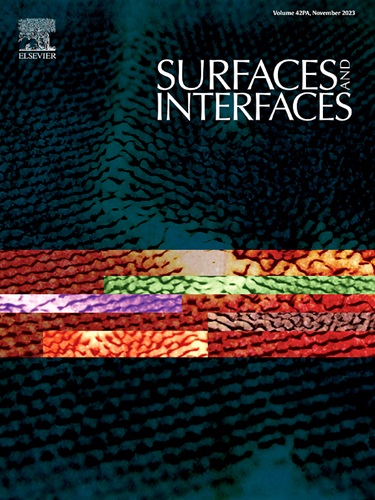Janus功能化钼单分子层
IF 6.3
2区 材料科学
Q2 CHEMISTRY, PHYSICAL
引用次数: 0
摘要
经实验合成的钼烯[Sahu etal ., Nat. nanotechnology . 18,1430(2023)]是唯一同时具有金属特性的Dirac材料。这种创新材料具有各种独特而突出的性能,表明在多个领域的重大潜在应用。然而,独立的钼结构的不稳定性对其可能的应用施加了相当大的限制。为了解决这一问题,我们通过X和Y原子的双功能化设计了105个Janus单层结构(X/Y = H、Li、Be、B、C、N、O、F、Na、Mg、Al、Si、P、S、Cl;X≠Y)在独立的钼烯(定义为Mo₂XY)的两个基面上,旨在获得稳定的钼烯单层衍生物。利用密度泛函理论(DFT)计算和从头算分子动力学(AIMD)模拟,我们系统地研究了这105种Mo₂XY结构的能量、力学、动力学和热力学稳定性。值得注意的是,我们的计算揭示了两种完全稳定的双面钼烯单层衍生物,即Mo2HF和Mo2OMg。我们还研究了这两种Janus单层膜的力学和电子性能。我们的研究不仅通过在两个表面的化学官能化稳定了独立的钼烯,而且还引入了两种新的稳定的双面钼烯单层衍生物,为其未来的应用提供了重要的理论基础。本文章由计算机程序翻译,如有差异,请以英文原文为准。

Janus functionalized molybdenene monolayers
Molybdenene, having been experimentally synthesized [Sahu et al., Nat. Nanotechnol. 18, 1430 (2023)], is the only Dirac material which concurrently possesses metallic characteristics. This innovative material has a variety of unique and outstanding properties, indicating significant potential applications across several fields. However, the instability of the free-standing molybdenene structure imposes considerable constraints on its possible use. To solve this problem, we designed 105 Janus monolayer structures by dual functionalization with X and Y atoms (X/Y = H, Li, Be, B, C, N, O, F, Na, Mg, Al, Si, P, S, Cl; X ≠ Y) on both basal planes of free-standing molybdenene (defined as Mo₂XY), aiming to achieve stable molybdenene monolayer derivatives. Using density functional theory (DFT) calculations and ab initio molecular dynamics (AIMD) simulations, we systematically investigated the energetic, mechanical, dynamical, and thermodynamical stability of these 105 Mo₂XY structures. Remarkably, our calculations revealed two completely stable Janus molybdenene monolayer derivatives, i.e., Mo2HF and Mo2OMg. We also investigated the mechanical and electronic properties of these two Janus monolayers. Our study not only stabilizes the free-standing molybdenene via chemical functionalization at both two surfaces, but also introduces two novel stable Janus molybdenene monolayer derivatives, providing a critical theoretical foundation for their future applications.
求助全文
通过发布文献求助,成功后即可免费获取论文全文。
去求助
来源期刊

Surfaces and Interfaces
Chemistry-General Chemistry
CiteScore
8.50
自引率
6.50%
发文量
753
审稿时长
35 days
期刊介绍:
The aim of the journal is to provide a respectful outlet for ''sound science'' papers in all research areas on surfaces and interfaces. We define sound science papers as papers that describe new and well-executed research, but that do not necessarily provide brand new insights or are merely a description of research results.
Surfaces and Interfaces publishes research papers in all fields of surface science which may not always find the right home on first submission to our Elsevier sister journals (Applied Surface, Surface and Coatings Technology, Thin Solid Films)
 求助内容:
求助内容: 应助结果提醒方式:
应助结果提醒方式:


